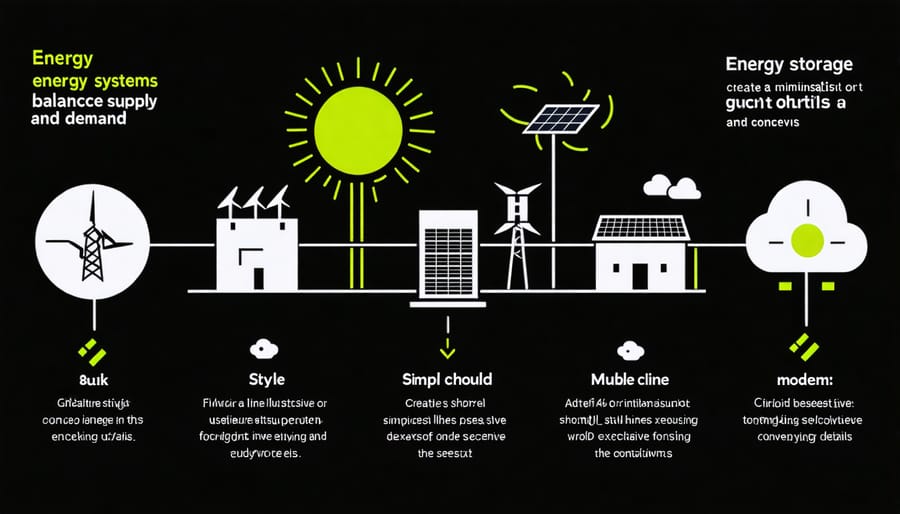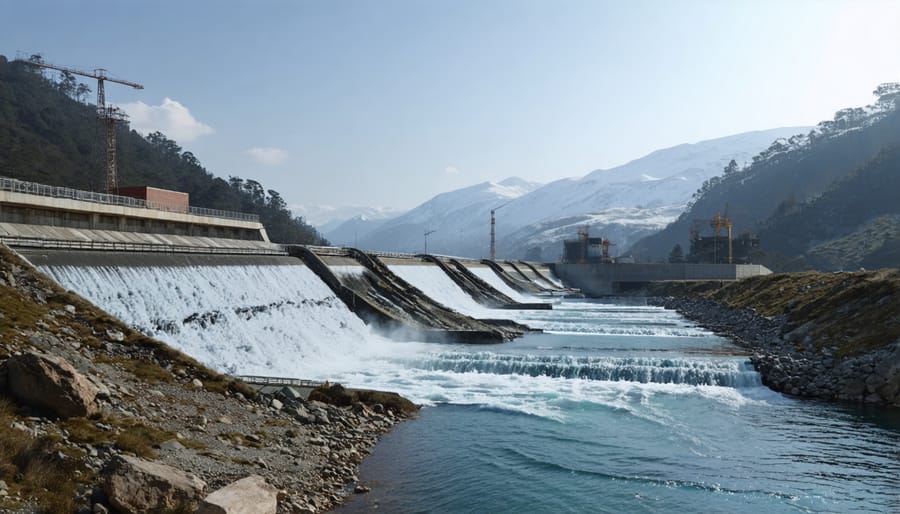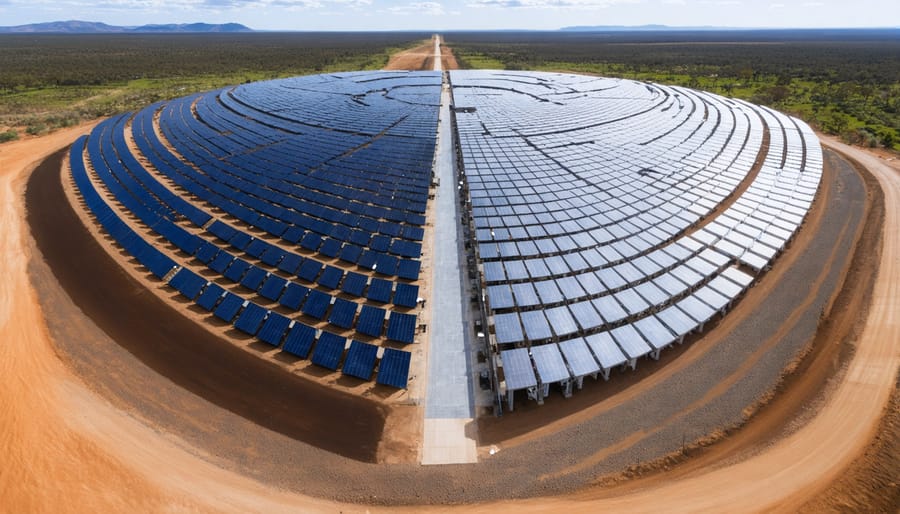The transition to renewable energy represents one of the most significant transformations in modern power systems, with grid integration emerging as the critical bridge between intermittent clean energy sources and reliable power delivery. As Australia leads the global charge with over 30% of households sporting rooftop solar, the challenge of harmoniously integrating these distributed energy resources into our century-old grid infrastructure has never been more pressing.
The intelligent integration of renewable energy into power grids isn’t just an engineering challenge – it’s the cornerstone of our sustainable energy future. From sophisticated battery storage systems in South Australia to innovative demand response programs in Victoria, Australian communities are pioneering solutions that transform how we think about power distribution and consumption.
Beyond the technical aspects, successful grid integration represents a delicate balance between maintaining grid stability, maximizing renewable energy utilization, and ensuring affordable power for all Australians. Through advanced forecasting technologies, smart grid solutions, and strategic energy storage deployment, we’re witnessing the evolution of a more resilient, flexible, and sustainable power system that can accommodate an ever-increasing share of renewable energy.
This remarkable transformation showcases how technology, policy, and innovation converge to reshape our energy landscape, setting new standards for global renewable energy integration.
Why Storage Systems Are Critical for Renewable Energy
Managing Peak Demand and Supply
Managing peak demand and supply in the renewable energy grid requires sophisticated storage systems working in harmony with advanced renewable energy forecasting technologies. Modern storage solutions, such as grid-scale batteries and pumped hydro facilities, act as essential buffers that help smooth out the natural variations in renewable energy generation.
In Australia, the perfect example is the Hornsdale Power Reserve in South Australia, affectionately known as the “Big Battery.” This massive Tesla installation has proven remarkably effective at maintaining grid stability during peak periods and unexpected outages. When the sun isn’t shining or the wind isn’t blowing, these storage systems release stored energy to meet demand, ensuring a reliable power supply.
The key to successful peak management lies in the strategic deployment of diverse storage technologies. While batteries provide rapid response capabilities for short-term fluctuations, pumped hydro facilities like Snowy 2.0 offer longer-duration storage capacity. This multi-layered approach, combined with smart grid technologies, helps maintain the delicate balance between supply and demand, making renewable energy integration more reliable and efficient than ever before.

Grid Stability Solutions
Energy storage systems are proving to be the backbone of grid stability as Australia transitions to renewable energy. These systems act like giant batteries, stepping in to maintain consistent power flow when the sun isn’t shining or the wind isn’t blowing. By storing excess energy during peak production periods and releasing it when needed, storage solutions help maintain the critical balance between power supply and demand.
In South Australia, the Hornsdale Power Reserve has demonstrated how large-scale batteries can respond to frequency variations within milliseconds, preventing potential blackouts and maintaining grid stability. This quick response capability is particularly valuable during sudden changes in renewable energy generation or unexpected power plant outages.
Beyond batteries, pumped hydro facilities like Snowy 2.0 provide longer-duration storage that helps regulate voltage levels across the grid. These systems work by pumping water uphill when excess power is available and releasing it through turbines when additional electricity is needed, effectively acting as a massive natural battery.
Modern grid operators are increasingly combining multiple storage technologies, creating a robust network that can respond to both short-term fluctuations and longer-duration stability needs. This hybrid approach ensures reliable power delivery while maximizing the integration of renewable energy sources.
Storage Technologies Transforming Australian Grids
Battery Energy Storage Systems
Battery Energy Storage Systems (BESS) have emerged as a game-changing solution for integrating renewable energy into Australia’s power grid. As Australia’s battery industry continues to grow, these large-scale installations are transforming how we manage and distribute clean energy across the nation.
The Hornsdale Power Reserve in South Australia, affectionately known as the “Big Battery,” stands as a shining example of BESS success. Since its installation, this massive 150-megawatt system has saved consumers millions of dollars while providing crucial grid stability during peak demand periods and unexpected outages.
These battery systems serve multiple critical functions in renewable energy integration. They smooth out the natural variability of solar and wind power, storing excess energy during peak production times and releasing it when needed. This capability helps maintain grid frequency, provides backup power during emergencies, and enables better management of energy supply and demand.
The benefits extend beyond just energy storage. BESS installations create local jobs, reduce reliance on fossil fuel-powered peaker plants, and help stabilize electricity prices. They also enable remote communities to establish more reliable and sustainable power supplies, particularly in areas where traditional grid connections are challenging or costly.
As technology advances and costs continue to fall, battery storage systems are becoming increasingly viable for both utility-scale applications and smaller community projects, paving the way for a more resilient and sustainable energy future.

Pumped Hydro Storage
Pumped hydro storage stands as Australia’s most established and largest-scale energy storage solution, playing a crucial role in stabilizing our renewable energy grid. The iconic Snowy Hydro scheme, with its massive 4,100MW capacity, demonstrates the proven reliability of this technology. During periods of excess solar and wind generation, water is pumped uphill to elevated reservoirs, essentially storing energy like a giant battery. When electricity demand peaks, this water is released through turbines, generating power within minutes.
Several exciting projects are currently reshaping Australia’s energy landscape. The Snowy 2.0 expansion will add 2,000MW of pumped hydro capacity, enough to power three million homes. In Tasmania, the Battery of the Nation initiative aims to develop multiple pumped hydro sites, potentially delivering 2,500MW of dispatchable capacity. Queensland is also embracing this technology with the proposed Borumba pumped hydro project, which could provide 2,000MW of storage capacity.
What makes pumped hydro particularly attractive is its long operational life – typically 50 to 100 years – and its ability to store massive amounts of energy at a relatively low cost. These facilities can operate continuously for several days, providing a reliable backup during extended periods of low wind or solar generation. For our journey towards 100% renewable energy, pumped hydro represents a tested, scalable solution that’s already proving its worth in our national energy mix.
Emerging Storage Solutions
As Australia leads the charge in renewable energy innovation, emerging storage solutions are revolutionising how we manage intermittent power sources. Hydrogen storage has emerged as a particularly promising frontier, offering a versatile solution for long-term energy storage. By using surplus renewable energy to split water into hydrogen and oxygen, this technology creates a clean fuel that can be stored indefinitely and converted back to electricity when needed.
Several pioneering projects across the country are demonstrating the potential of hydrogen storage. The Hydrogen Park South Australia (HyP SA) facility showcases how excess solar energy can be transformed into hydrogen, providing a reliable backup for the grid during peak demand periods.
Beyond hydrogen, flow batteries are gaining traction as a scalable storage option. Unlike traditional batteries, these systems store energy in liquid electrolytes, making them ideal for large-scale applications. The technology’s ability to decouple power from energy capacity offers unprecedented flexibility in grid storage design.
Thermal energy storage is another innovative approach making waves in the Australian market. By converting excess renewable energy into heat, stored in materials like molten salt or phase-change materials, these systems can provide on-demand power while maintaining grid stability.
These emerging technologies complement existing storage solutions, creating a diverse ecosystem of options that can be tailored to specific grid requirements and geographical conditions. As costs continue to decrease and efficiency improves, these storage solutions are becoming increasingly viable for widespread adoption.
Successful Integration Stories

South Australia’s Big Battery
South Australia’s Hornsdale Power Reserve, affectionately known as the “Big Battery,” stands as a shining example of how large-scale renewable projects can revolutionize power grid stability. Since its installation in 2017, this 150-megawatt Tesla battery system has exceeded expectations, proving that renewable energy storage is both practical and profitable.
The battery serves multiple critical functions: it provides essential grid stability services, prevents blackouts during extreme weather events, and helps integrate wind and solar power more effectively into the grid. Within its first year of operation, the Big Battery saved consumers more than $50 million by efficiently managing peak demand and providing frequency control services.
During the 2019 Queensland power station failure, the Hornsdale Power Reserve responded in just milliseconds, helping prevent a potential system-wide blackout. This rapid response capability has transformed how grid operators view battery storage solutions, demonstrating that renewable energy systems can provide reliability that matches or exceeds traditional power sources.
The success of the Big Battery has inspired similar projects across Australia and worldwide. It’s shown that large-scale energy storage isn’t just environmentally responsible – it’s a smart business decision that delivers real benefits to communities and energy consumers while supporting the transition to renewable energy.
Community-Scale Projects
Across Australia, community-scale renewable energy projects are demonstrating the practical benefits of integrated storage solutions. The Byron Bay Solar Farm, for instance, combines a 5MW solar installation with battery storage to power over 1,500 local homes while maintaining grid stability. This clever setup allows the community to utilise solar energy even after sunset, significantly reducing their reliance on traditional power sources.
In South Australia, the Salisbury Community Battery project showcases how neighbourhoods can work together to maximise their renewable energy usage. The 30kWh battery system serves around 100 households with rooftop solar, helping residents share excess energy and reduce their power bills while supporting grid reliability during peak demand periods.
The Yackandandah mini-grid in Victoria stands out as another brilliant example of community-scale storage. This innovative project connects multiple households through a smart grid system, incorporating both individual and shared battery storage. The result? A more resilient and self-sufficient energy network that’s helped the township progress towards its 100% renewable energy goal.
These success stories highlight how smaller communities can effectively manage the intermittent nature of renewable energy through smart storage solutions. They’re proving that local-scale projects aren’t just feasible – they’re thriving, cost-effective ways to transition towards a more sustainable energy future while maintaining grid stability and community engagement.
Future-Proofing Australia’s Grid
Planned Developments
Australia is poised for a remarkable transformation in renewable energy integration, with several groundbreaking projects on the horizon. The Snowy 2.0 pumped hydro project, set to become one of the world’s largest energy storage systems, will provide 2,000 megawatts of dispatchable power, supporting the integration of variable renewable energy sources across the National Electricity Market.
Victoria’s Big Battery project is expanding its capacity, while Western Australia is developing an innovative virtual power plant network that will coordinate thousands of residential battery systems. South Australia is pioneering the world’s first grid-scale vanadium flow battery, which promises longer duration storage capabilities than conventional lithium-ion systems.
Queensland’s renewable energy zones are being equipped with advanced storage solutions, including compressed air energy storage facilities and strategic battery installations. These developments are complemented by nationwide initiatives to upgrade transmission infrastructure and implement smart grid technologies.
The Australian Renewable Energy Agency (ARENA) is funding several pilot projects exploring innovative storage technologies, including hydrogen storage and thermal energy solutions, demonstrating Australia’s commitment to leading the global transition to renewable energy.
Integration Challenges and Solutions
Integrating renewable energy into existing power grids presents several challenges that require innovative solutions. Voltage fluctuations and grid stability issues arise from the intermittent nature of solar and wind power, while distribution networks need significant upgrades to handle bi-directional power flows. However, Australia is making remarkable progress in addressing these challenges through smart technologies and strategic planning.
Advanced inverter systems, coupled with sophisticated grid management software, help maintain power quality and system stability. Energy storage solutions, including modern battery recycling solutions, play a crucial role in smoothing out supply variations and providing grid services.
Regulatory frameworks are evolving to support these technical solutions. The Australian Energy Market Operator (AEMO) has implemented new connection standards and market mechanisms that facilitate renewable integration while maintaining grid reliability. Virtual Power Plants (VPPs) are emerging as a promising solution, aggregating distributed energy resources to provide grid services and enhance system flexibility.
These challenges are increasingly viewed as opportunities for innovation rather than obstacles, driving the development of smarter, more resilient power systems across the country.
As Australia transitions towards a renewable energy future, storage systems stand as the cornerstone of successful grid integration. These technologies are not just optional additions but essential components that will determine the speed and success of our renewable energy adoption. The ability to store energy effectively transforms intermittent solar and wind power into reliable, dispatchable energy sources that can power our homes and businesses around the clock.
The future of Australia’s energy landscape looks promising, with storage solutions playing multiple crucial roles: stabilizing the grid, providing backup power during peak demand, and enabling the efficient use of renewable resources. From household battery systems to large-scale hydrogen storage facilities and pumped hydro projects, these technologies are already proving their worth in communities across the country.
As we’ve seen in successful implementations throughout Australia, storage systems are becoming more cost-effective and efficient each year. This trend, combined with continued technological improvements and supportive policies, positions Australia to become a global leader in renewable energy integration. The benefits extend beyond environmental protection to include economic advantages, job creation, and enhanced energy security for remote communities.
Looking ahead, the continued development and deployment of storage systems will be vital in achieving Australia’s renewable energy targets and ensuring a sustainable energy future for generations to come. With proper investment, innovation, and commitment, storage technologies will help us build a more resilient and sustainable power grid that serves as a model for the world.

